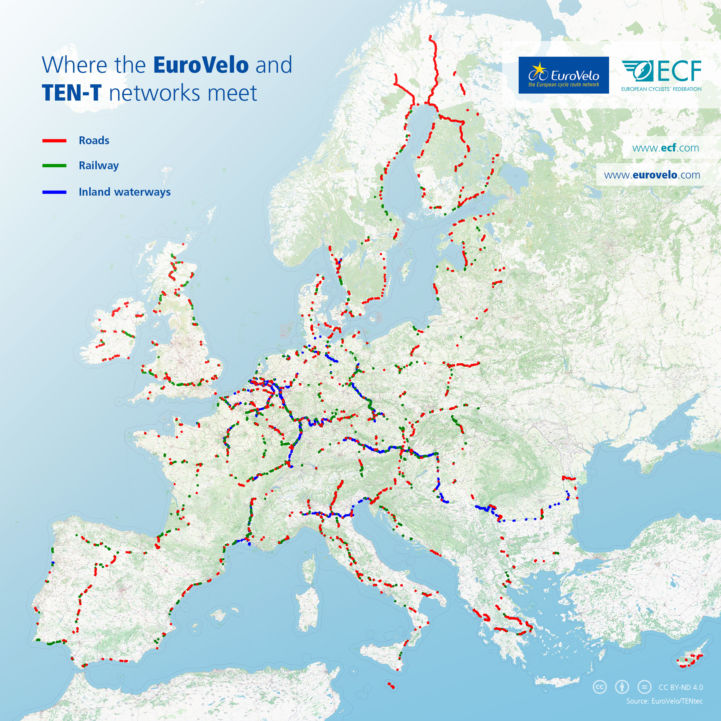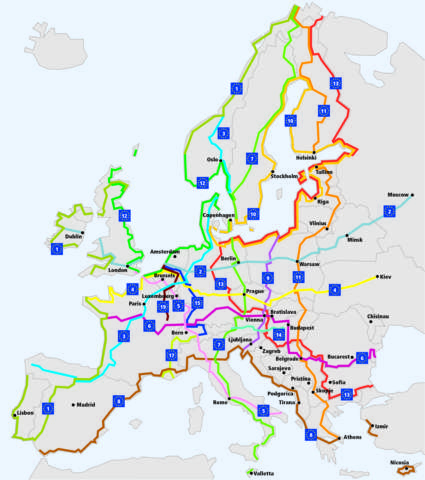Close friends: EuroVelo connects with TEN-T network nearly 8,000 times
What is TEN-T?
The Trans-European Transport Network (TEN-T) is an EU policy addressing the development of a Europe-wide network of railway lines, roads and inland waterways. A reference to cycling and EuroVelo was included in the TEN-T Guidelines for the first time in 2014, following a campaign by the ECF. Including bicycle infrastructure for long-distance cycling paths like the EuroVelo routes on bridges or in tunnels was given as an example of exploiting synergies between TEN-T and other policies.
How often does TEN-T meet EuroVelo?
To gain an understanding of how much potential there is to integrate cycling into all TEN-T infrastructure projects, the ECF has overlayed the EuroVelo network with the current TEN-T networks: roads, railways and inland waterways. This shows that there are 2,652 locations in the EU+UK where the EuroVelo routes run along or across TEN-T roads. The total length of sections where these two networks overlap adds up to 3,337 km. This includes bridges and sections of the roads leading to them, but also narrow mountain valleys, coastal lines, or roads leading up to border crossings. For the TEN-T railway network, the overlap concerns 3,336 locations and 1,901 km (more crossings, fewer shared stretches). For TEN-T inland waterways, there are 1,873 joint locations and 4,688 shared kilometres – not surprisingly, as many EuroVelo routes follow major navigable canals and rivers, such as the Rhine or Danube.

Altogether, the sections overlapping with the TEN-T represent more than 10% of the entire EuroVelo network.
Number of intersections with the EuroVelo network:
- TEN-T roads: 2,652
- TEN-T railways: 3,336
- TEN-T inland waterways: 1,873
Total length of overlaps with the EuroVelo network:
- TEN-T roads: 3,337 km
- TEN-T railways: 1,901 km
- TEN-T inland waterways: 4,688 km
How were the numbers calculated?
The numbers include the EU and UK, but not the Western Balkan or Eastern Neighbourhood countries, where EU-funded TEN-T projects are also implemented. The newest addition to the European cycle network, EuroVelo 14 – Waters of Central Europe, was also not included in the analysis. For matching the tracks along roads and rails, we assumed a maximum distance of 100 m between the two networks. For inland waterways, we set this number to 500 m measured from the middle of the water, as some rivers are wide and embankments can be a bit further away. As we based the analysis on the current EuroVelo itineraries, certainly not all the common corridors were captured. For example, long sections of EuroVelo 6 are located at a distance of a few kilometres from the Danube in Romania and Bulgaria, as there are no roads or rideable tracks closer to the river.
The EuroVelo routes of course only represent a part of the picture. They form the backbone of much denser national, regional and local cycle route networks. The opportunities and the need to incorporate cycling infrastructure into TEN-T projects is therefore far greater than the numbers referred to in the paragraphs above.

 TEN-T core network corridors (left) and EuroVelo long-distance cycle routes network (right)
TEN-T core network corridors (left) and EuroVelo long-distance cycle routes network (right)
How often is the synergy exploited? Not often enough! We will give a few examples of good practices among the recent TEN-T projects in a separate article, but many if not most opportunities are still missed. Sometimes the TEN-T projects even create new barriers for cycling instead of improving the conditions for active mobility.
What next?
With the upcoming revision of the TEN-T guidelines, the ECF aims to better integrate cycling into the trans-European networks and projects. We advocate for including two major changes in the revision:
- 1. Recognition of EuroVelo, the European cycle route network, as a fully-fledged TEN-T network.
- 2. Integration of cycling into projects on other TEN-T networks. That means that when building or upgrading a railroad line, for instance, the potential for cycling along and across the line should be evaluated, and key elements such as bridges and tunnels should be integrated into the project.
Find out more on ECF's dedicated webpage on TEN-T, EuroVelo and cycling.
Author: Aleksander Buczyński
